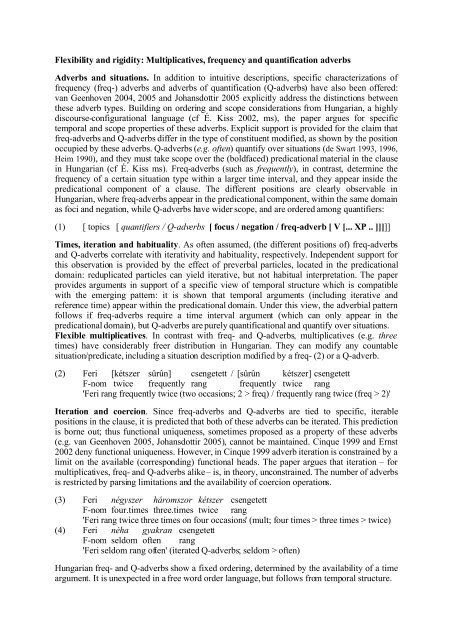Flexibility and rigidity: Multiplicatives, frequency and ... - Linguistics
Flexibility and rigidity: Multiplicatives, frequency and ... - Linguistics
Flexibility and rigidity: Multiplicatives, frequency and ... - Linguistics
Create successful ePaper yourself
Turn your PDF publications into a flip-book with our unique Google optimized e-Paper software.
<strong>Flexibility</strong> <strong>and</strong> <strong>rigidity</strong>: <strong>Multiplicatives</strong>, <strong>frequency</strong> <strong>and</strong> quantification adverbs<br />
Adverbs <strong>and</strong> situations. In addition to intuitive descriptions, specific characterizations of<br />
<strong>frequency</strong> (freq-) adverbs <strong>and</strong> adverbs of quantification (Q-adverbs) have also been offered:<br />
van Geenhoven 2004, 2005 <strong>and</strong> Johansdottir 2005 explicitly address the distinctions between<br />
these adverb types. Building on ordering <strong>and</strong> scope considerations from Hungarian, a highly<br />
discourse-configurational language (cf É. Kiss 2002, ms), the paper argues for specific<br />
temporal <strong>and</strong> scope properties of these adverbs. Explicit support is provided for the claim that<br />
freq-adverbs <strong>and</strong> Q-adverbs differ in the type of constituent modified, as shown by the position<br />
occupied by these adverbs. Q-adverbs (e.g. often) quantify over situations (de Swart 1993, 1996,<br />
Heim 1990), <strong>and</strong> they must take scope over the (boldfaced) predicational material in the clause<br />
in Hungarian (cf É. Kiss ms). Freq-adverbs (such as frequently), in contrast, determine the<br />
<strong>frequency</strong> of a certain situation type within a larger time interval, <strong>and</strong> they appear inside the<br />
predicational component of a clause. The different positions are clearly observable in<br />
Hungarian, where freq-adverbs appear in the predicational component, within the same domain<br />
as foci <strong>and</strong> negation, while Q-adverbs have wider scope, <strong>and</strong> are ordered among quantifiers:<br />
(1) [ topics [ quantifiers / Q-adverbs [ focus / negation / freq-adverb [ V [... XP .. ]]]]]<br />
Times, iteration <strong>and</strong> habituality. As often assumed, (the different positions of) freq-adverbs<br />
<strong>and</strong> Q-adverbs correlate with iterativity <strong>and</strong> habituality, respectively. Independent support for<br />
this observation is provided by the effect of preverbal particles, located in the predicational<br />
domain: reduplicated particles can yield iterative, but not habitual interpretation. The paper<br />
provides arguments in support of a specific view of temporal structure which is compatible<br />
with the emerging pattern: it is shown that temporal arguments (including iterative <strong>and</strong><br />
reference time) appear within the predicational domain. Under this view, the adverbial pattern<br />
follows if freq-adverbs require a time interval argument (which can only appear in the<br />
predicational domain), but Q-adverbs are purely quantificational <strong>and</strong> quantify over situations.<br />
Flexible multiplicatives. In contrast with freq- <strong>and</strong> Q-adverbs, multiplicatives (e.g. three<br />
times) have considerably freer distribution in Hungarian. They can modify any countable<br />
situation/predicate, including a situation description modified by a freq- (2) or a Q-adverb.<br />
(2) Feri [kétszer sûrûn] csengetett / [sûrûn kétszer] csengetett<br />
F-nom twice frequently rang frequently twice rang<br />
'Feri rang frequently twice (two occasions; 2 > freq) / frequently rang twice (freq > 2)'<br />
Iteration <strong>and</strong> coercion. Since freq-adverbs <strong>and</strong> Q-adverbs are tied to specific, iterable<br />
positions in the clause, it is predicted that both of these adverbs can be iterated. This prediction<br />
is borne out; thus functional uniqueness, sometimes proposed as a property of these adverbs<br />
(e.g. van Geenhoven 2005, Johansdottir 2005), cannot be maintained. Cinque 1999 <strong>and</strong> Ernst<br />
2002 deny functional uniqueness. However, in Cinque 1999 adverb iteration is constrained by a<br />
limit on the available (corresponding) functional heads. The paper argues that iteration – for<br />
multiplicatives, freq- <strong>and</strong> Q-adverbs alike – is, in theory, unconstrained. The number of adverbs<br />
is restricted by parsing limitations <strong>and</strong> the availability of coercion operations.<br />
(3) Feri négyszer háromszor kétszer csengetett<br />
F-nom four.times three.times twice rang<br />
'Feri rang twice three times on four occasions' (mult; four times > three times > twice)<br />
(4) Feri néha gyakran csengetett<br />
F-nom seldom often rang<br />
'Feri seldom rang often' (iterated Q-adverbs; seldom > often)<br />
Hungarian freq- <strong>and</strong> Q-adverbs show a fixed ordering, determined by the availability of a time<br />
argument. It is unexpected in a free word order language, but follows from temporal structure.
References<br />
Cinque, G. 1999. Adverbs <strong>and</strong> Functional Heads. Oxford: Oxford University Press<br />
É. Kiss, K. 2002. The Syntax of Hungarian. Cambridge: Cambridge University Press<br />
É. Kiss, K. ms. Free word order, (non-)configurationality <strong>and</strong> phases. ms, Research Institute of<br />
<strong>Linguistics</strong>, Hungarian Academy of Sciences<br />
Ernst, T. 2002. The Syntax of Adjuncts. Cambridge: Cambridge University Press<br />
van Geenhoven, V. 2004. For-adverbials, frequentative aspect, <strong>and</strong> pluractionality. Natural<br />
Language Semantics. 12<br />
van Geenhoven, V. 2005. Atelicity, Pluractionality, <strong>and</strong> Adverbial Quantification. in H.<br />
Verkuyl, H. de Swart <strong>and</strong> A. van Hout (eds) Perspectives on Aspect. Dordrecht: Springer<br />
Johansdottir, K. 2005. Temporal adverbs in Icel<strong>and</strong>ic: Adverbs of quantification vs. <strong>frequency</strong><br />
adverbs. Working Papers in Sc<strong>and</strong>inavian Syntax 76<br />
Heim, I. 1990. E-type pronouns <strong>and</strong> donkey anaphora. <strong>Linguistics</strong> <strong>and</strong> Philosophy 13<br />
de Swart, H. 1993. Adverbs of Quantification: A Generalized Quantifier Approach. New York<br />
<strong>and</strong> London: Garl<strong>and</strong><br />
de Swart, H. 1996. (In)definites <strong>and</strong> genericity. in M. Kanazawa, C. Piñon <strong>and</strong> H. de Swart<br />
(eds) Quantifiers, Deduction <strong>and</strong> Context. Stanford: CSLI
















